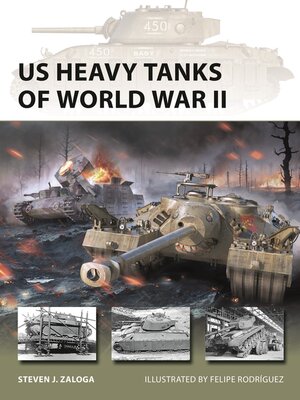
Sign up to save your library
With an OverDrive account, you can save your favorite libraries for at-a-glance information about availability. Find out more about OverDrive accounts.
Find this title in Libby, the library reading app by OverDrive.



Search for a digital library with this title
Title found at these libraries:
| Library Name | Distance |
|---|---|
| Loading... |
Through World War II the US Army worked on projects for new heavy tanks, which are charted in this illustrated study of the M6 and the never-built T14, T28, and Pershing-derived designs.
In this book, world-renowned armour expert Steven J. Zaloga examines the US Army's efforts to field a heavy tank in World War II. The first design was the M6, which never saw combat use despite being type classified. The heavy T14 assault tank, earmarked for the British under Lend-Lease, was also developed, while the M4A3E2 assault tank went into production as a stopgap for the 1944 campaign in France. The most outrageous US tank project of the war was the T28/T95 superheavy tank, which was so large that it required four sets of suspension bogies instead of the usual two.
The M26 Pershing medium tank program also spawned a number of heavy tank projects, such as the T29, T30 and T34, which are also examined. Although production of these was envisioned in 1945–46, the end of the war put an end to any possibility of serial manufacture. Nevertheless, these tanks were heavily influenced by World War II lessons and their development and technical features are examined.
Illustrated with rarely seen archive photos and meticulously illustrated new profiles of the key designs, this book traces the US Army's efforts to develop heavy tanks comparable to the German Tigers, and the reasons why such monstrous machines were never required.
In this book, world-renowned armour expert Steven J. Zaloga examines the US Army's efforts to field a heavy tank in World War II. The first design was the M6, which never saw combat use despite being type classified. The heavy T14 assault tank, earmarked for the British under Lend-Lease, was also developed, while the M4A3E2 assault tank went into production as a stopgap for the 1944 campaign in France. The most outrageous US tank project of the war was the T28/T95 superheavy tank, which was so large that it required four sets of suspension bogies instead of the usual two.
The M26 Pershing medium tank program also spawned a number of heavy tank projects, such as the T29, T30 and T34, which are also examined. Although production of these was envisioned in 1945–46, the end of the war put an end to any possibility of serial manufacture. Nevertheless, these tanks were heavily influenced by World War II lessons and their development and technical features are examined.
Illustrated with rarely seen archive photos and meticulously illustrated new profiles of the key designs, this book traces the US Army's efforts to develop heavy tanks comparable to the German Tigers, and the reasons why such monstrous machines were never required.







